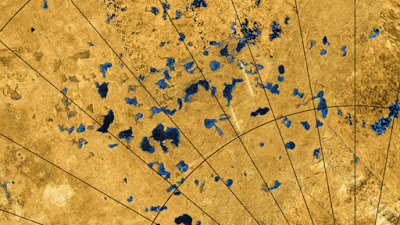 |
| Image: NASA |
These images by Cassini are a result of a successful flyby during which it took the surface photos. In August, it will make its final flyby of Titan dropping 295 miles near to its surface after which it will make preparations to dive in the space between Saturn and its rings.
Titan is the only natural satellite in the solar system that is considered to be most similar to Earth. The presence of methane and ethane suggest the presence of hydrocarbons. The liquid methane can also be thought of as equivalent to Earth’s water. Apart from the seas, and lakes, the photos received also suggest the presence of empty depressions, steep walls etc. The lakes were thought to be filled by rainfall and the water that is fed to them from under the ground. It was also found that these lakes were the remains of what are known as krastic landforms on earth and are a result of the erosion of rocks like limestone and gypsum. The rate of this erosion is dependent on factors such as composition of rocks, rainfall rate and surface temperatures.
In the end, the scientists concluded that it would take 50 million years on the surface of Titan at the Polar Regions for the formation of a depression about 300-foot long. At the lower latitudes, where the rainfall is less, the lake depressions would take about 375 million years to form.





















